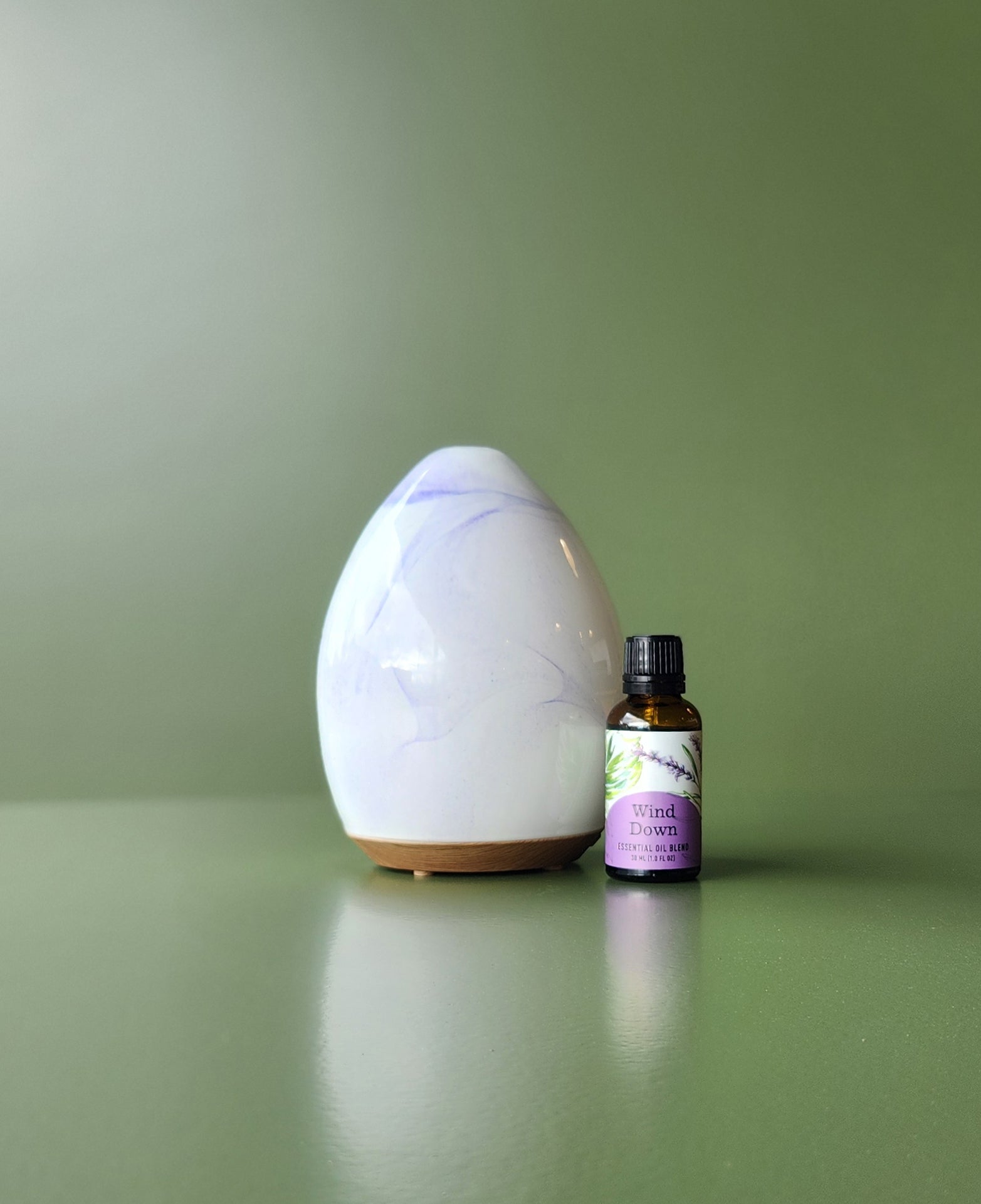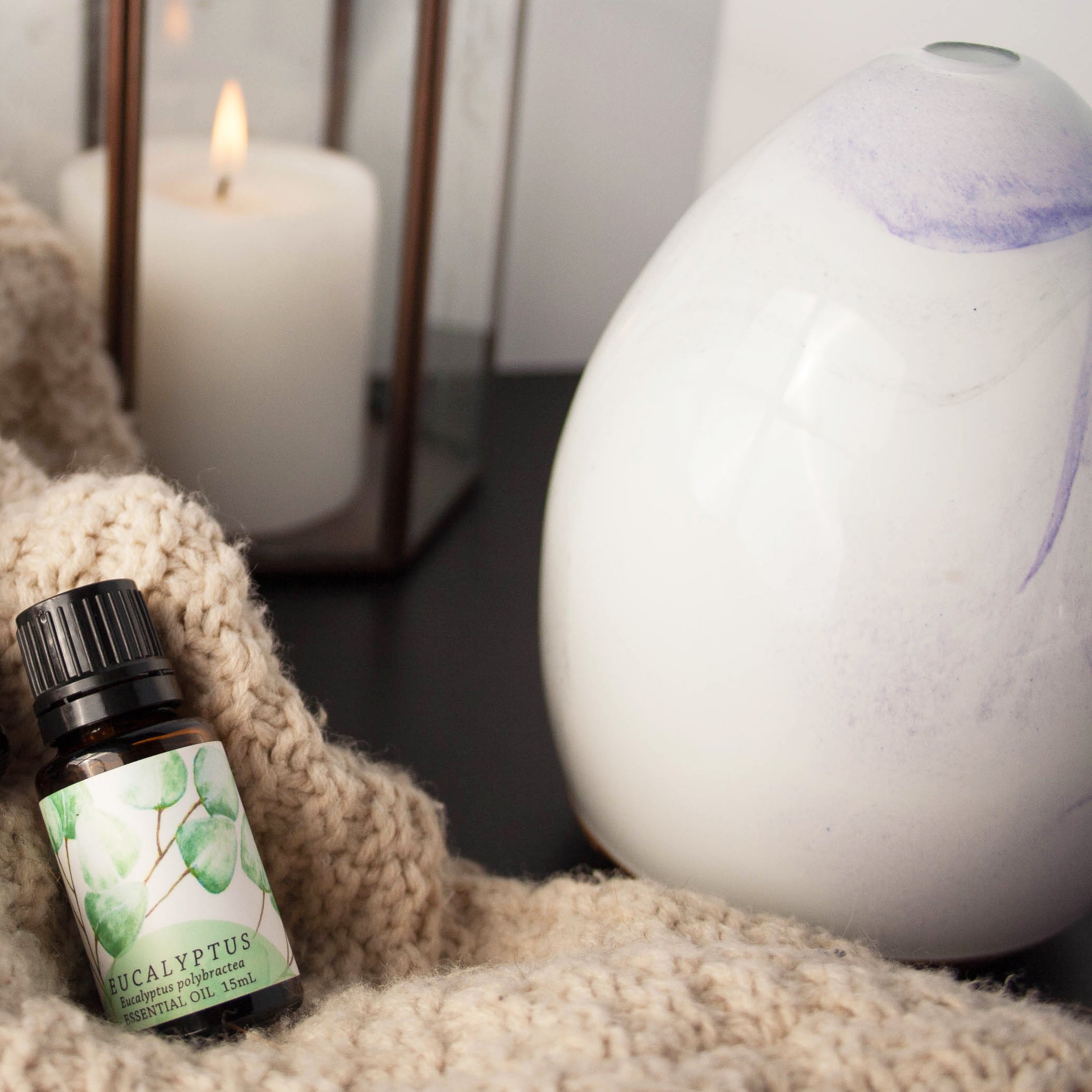

Glass Swirl USB Ultrasonic Essential Oil Diffuser
- Hand blown glass exterior with faux wood base
- 4 Light modes: warm white, color rotating, color fixed and off
- 5 Hour run time with automatic shut off
Product Specs:
- BPA free plastic interior
- Plugs into any USB port
- Covers 400 sq. feet
- 60 mL capacity
Click here to learn more about our essential oils and their use.
Good to Know
How it Works:
The Glass Swirl Diffuser uses high frequency ultrasonic technology that vibrates water in the unit into an ultra fine mist. When essential oils are added, they are immediately dispersed into the air, providing immediate healthful benefits while helping to ionize the air. It can be use in a bedroom, living room, office area, or anywhere you want to create a relaxing, healthful environment.
Directions for Use:
- Remove glass cover and plastic insert, plug the USB cable (included) to the unit, then connect to a USB port (port not included).
- Using a cup, fill with lukewarm tap water up to the max fill line. Do not fill above max fill line. Add 5 to 10 drops of your essential oil and reassemble cover.
- To activate mist and rotating lights:
Power Button (on right):
- Touch the power button once to begin misting continuously
- Touch the power button twice to turn off misting
Light Button (on left):
- Press the light button once for warm white light
- Press the light button twice for color rotating lights
- Press the light button 3 times to select a color
- Press the light button 4 times to turn light off
- DO NOT FILL ABOVE MAX LINE
- DO NOT ALLOW WATER TO ENTER THE AIR VENT
- DO NOT FILL BASE UNDER RUNNING WATER
Cleaning Maintenance
- Disconnect from power before cleaning
- Remove glass cover and plastic insert and "energy ring" (covering the sensor at bottom of inside)
- Rinse inside with warm water
- Wipe with soft damp cloth to clean
- Wipe with soft cloth and rubbing alcohol when needed to break up excessive oil residue (Do not use detergents, solvents, or abrasive agents to clean the diffuser.)
- Using a cotton swab with warm water, gently clean the mist disc and sensor located at the inside bottom of the base.
- Replace "energy ring" and lid after cleaning
- NOTE: Oil mist may damage wooden and painted surface. Wipe up any residue quickly and often.
Troubleshooting
No Mist, Little Mist or Spraying
- Using incorrect water, distilled or purified > Use Tap Water (without filter)
- Unit is out of water > Add additional water
- Unit needs to be cleaned. Oils are clinging to ceramic disc or sensor. > Clean unit as advised above. Pay particular attention to swab the sensor/disc inside the bottom of the unit
- Water level is higher than max level line> Clean unit and add water 1/2 way to fill line and then additional water after getting mist
- Cover is not assembled correctly > Make sure cover is aligned properly
- Water is too cold > Change to warmer water
Blinking Lights
- Water level indicator is dirty > Clean unit as advised above. Pay particular attention to swab the sensor/disc inside the bottom of the unit
Unit will not stop running even though empty
- Water level indicator is dirty > Clean unit as advised above. Pay particular attention to swab the sensor/disc inside the bottom of the unit
How do essential oils work?
Essential oils have been used for thousands of years for their therapeutic properties. They work in two main ways:
- Through inhalation – Aromatic molecules travel through the nose, triggering reactions in the brain.
- Through the skin – Their tiny molecules absorb into the body and can be detected in perspiration, urine, and breath.
Different oils have different effects—some are calming, others anti-inflammatory, and some even boost immunity.
What is the difference between fragrance oils, essential oils, and all-natural fragrances?
- Essential Oils – Pure plant extracts obtained via steam distillation or cold pressing.
- All-Natural Fragrances – A mix of essential oils and natural ingredients. These are the only types we use.
- Fragrance Oils (Perfumes) – Can include essential oils, natural fragrances, and artificial aroma chemicals. Many brands use artificial fragrances to cut costs, but their full ingredient lists are often hidden.
Why do essential oil prices vary so much?
The price of essential oils depends on factors like plant yield, transportation costs, and growing conditions. Some plants require significantly more raw material to produce oil—for example, 1 lb. of Lavender Oil requires 1,000 lbs. of lavender, whereas 1 lb. of Rose Oil requires 600 TONS of roses!
Are your essential oils “therapeutic grade”?
"Therapeutic grade" is simply a marketing term—there is no third-party certification for essential oils. However, essential oils can be Certified Organic if they meet independent verification standards.
We source essential oils from Lebermuth (many of our Certified Organic!), a trusted supplier with over a century of experience.
How many drops of essential oil should I use in my diffuser?
A good rule of thumb is 3-5 drops per 100ml of water, but always check your diffuser’s capacity.
Are essential oils safe to ingest?
No. Unless under the guidance of a licensed practitioner, essential oils should not be taken internally, as some compounds can be toxic when ingested.
Can I apply essential oils directly to my skin?
No, essential oils should always be diluted in a carrier oil before applying to the skin. They are highly concentrated and can cause irritation if used undiluted.
Can I use essential oils during pregnancy?
Some essential oils should be avoided during pregnancy and lactation, including:
- Anise, Anise (Star), Araucaria, Artemisia vestita, Birch (Sweet), Black seed, Buchu, Calamint (lesser), Carrot Seed, Cassia, Chaste tree, Cinnamon bark, [ please note that we use Cinnamon Leaf, not bark ] Costus, Cypress (Blue), Dill seed (Indian), Fennel (bitter), Fennel (sweet), Feverfew, Genipi, Hibawood, Ho leaf, Hyssop, Lanyana, Lavender (Spanish) [ please note that we use Bulgarian Lavender or 40/42 Lavender sourced from USA ] Mugwort, Myrrh, Myrtle, Oregano, Parsely Leaf, Parsleyseed, Pennyroyal, Rue, Sage (Dalmation), Sage (Spanish), Savin, Tansy, Thuja, Western red cedar, Wintergreen, Wormwood, Yarrow, Zedoary
Others should be used in limited amounts. (We include Maximum dermal dose recommendation after each essential oil:
- Basil (lemon) 1.4%, Boswellia papyrifera 1.7%, Champaca (orange) absolute 17.5%, Lemon balm (Australian) 3.4%, Lemon leaf 1.2%, Lemongrass 0.7%, May chang 0.8%, Melissa 0.9%, Myrtle (honey) 0.9%, Myrtle (lemon) 0.7%, Nasturium absolute 0.26%, Tea Tree (lemon-scented) 0.8%, Thyme (lemon) 3.7%, Verbena (lemon) 0.9%
Always consult a healthcare provider before using essential oils during pregnancy.
What does “dermal use limit” mean?
This is the maximum recommended percentage of an essential oil that can be applied to the skin. Our guidelines are based on Essential Oil Safety by Robert Tisserand & Rodney Young, the industry standard for safe use.
If you experience irritation, discontinue use immediately. If using prescription topical medications, apply essential oils to a separate area of skin.
Who supplies your essential oils?
We source our essential oils from Lebermuth, a company with over 100 years of expertise in high-quality essential oils.
For more information and recipes, check out our comprehensive Essential Oil Guide.

Choose options


Clean Up With 10% Off
Our occasional emails will make you wish your screen was scratch and sniff!
Sign up and we'll share what's new and give you a peek into the art and craft of traditional soapmaking and aromatherapy.
Plus get 10% off your first order!
Natural & Genuine
Simple, plant-based ingredients and traditional methods
Learn More
$5 Flat Rate Shipping
Pay just $5 and we'll ship anywhere within the United States
See Shipping Policy
Happy Policy
Order with confidence, we ensure you are happy and satisfied!
See Return Policy
Customer Care
Have a product question, order issue or comment to share?
Reach us here!

